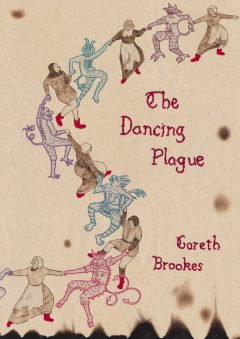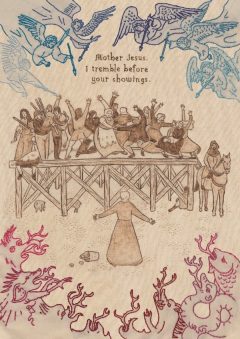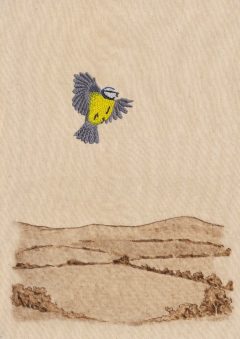Review: The Dancing Plague (SelfMadeHero)
‘The Dancing Plague’ was a real-life phenomenon – in 1518, people started dancing and couldn’t stop. This might sound entertaining, but Gareth Brookes’ take on the event showcases a much darker interpretation of one of history’s most bizarre and unexplainable epidemics.
 Publisher: SelfMadeHero
Publisher: SelfMadeHero
Writer: Gareth Brookes
Artist: Gareth Brookes
Price: Pre-order for £15.99 from SelfMadeHero
Gareth Brookes’ The Dancing Plague is a fictional account of an actual epidemic that occurred in 1518, in which fifty to four hundred people in Strasbourg, Alsace started wildly dancing for days on end. Weaving the true historical facts with a fictionalized narrative told by main character Mary, Brookes presents a supernatural interpretation of this unexplainable event. Coupled with his individualistic embroidery type art, this really is a standout graphic novel.
Without going too much into the plot (and spoiling the book for those who have pre-ordered it!), the novel focuses on the perspective of Mary – a witness to the epidemic, who appears to see demons controlling the dancers. Mary’s life has truly been tough, as we find out through a series of flashbacks: she experiences child abuse, religious persecution, and an arranged marriage. The flashbacks and the present-day narration are separated by ‘chapters’ of sorts, with a deliberately messy date embroidered in blood red.
 One of the stand-out qualities of this graphic novel is its experimental art style, through Brookes’ use of embroidery and pyrographic techniques. The astute use of embroidery and colour palettes depicts how ‘other’ the demon creatures are – most of the pages are a dusky brown colour, reflecting a ‘medieval’ vibe, but the other-worldly creatures which appear are stark and vibrant, a clear nod to how they stand out from the mundane and every day. The use of pyrography is also effective, particularly when used to indicate the ‘voice’ of God transcending the page.
One of the stand-out qualities of this graphic novel is its experimental art style, through Brookes’ use of embroidery and pyrographic techniques. The astute use of embroidery and colour palettes depicts how ‘other’ the demon creatures are – most of the pages are a dusky brown colour, reflecting a ‘medieval’ vibe, but the other-worldly creatures which appear are stark and vibrant, a clear nod to how they stand out from the mundane and every day. The use of pyrography is also effective, particularly when used to indicate the ‘voice’ of God transcending the page.
Mary serves as the perfect narrator for The Dancing Plague because of her visions, which means she can see what no one else can: that demons are puppeteering the dancers. As the dancing epidemic slowly but surely takes over the town and its people, many believe it is a religious punishment, an imbalance of the senses or even just the fault of women in general! Through Mary’s eyes, we can see the real culprits, and we’ll tell you now, they’re horrifying. Beautifully embroidered in a variety of vibrant colours, Brookes’ demons not only look terrifying, but act it too – pulling on people’s limbs to make them wildly gesticulate uncontrollably is pretty jarring, but there’s worse to come.
We encounter full page, full colour spreads of limbs being torn apart, people being eaten alive, thrown into volcanoes, and being excreted, in a grotesque depiction of the hellish torture the ‘dancing’ people experience beneath the surface. Close up panels of their bloody feet and hands show the physical, as well as mental ramifications of the epidemic. Brookes also subtly shows that these demons don’t have the same limits as people, as they are not restricted to the typical four panel page format he uses throughout: these demons can escape their panels, transcending human limitations, and slither around anywhere they like (this same concept is prevalent in Brecht Evens’ Panther, in which demonic creatures also transcend structure).
 Fortunately, there is the occasional dose of humour to lighten the mood. Brookes uses men’s interactions with Mary to subvert the sexism of this period: in this novel, sexist men, rather than women, are the butt of the joke. There are also touching moments to accompany the gloom and gore, one of our favourites of which is a flashback to Mary’s moment of triumph as she escapes her captivity, transforming into a small bird. This is beautifully rendered through Brookes’ colourful embroidery: he lets his art speak for itself for a few wordless panels, and it is truly powerful.
Fortunately, there is the occasional dose of humour to lighten the mood. Brookes uses men’s interactions with Mary to subvert the sexism of this period: in this novel, sexist men, rather than women, are the butt of the joke. There are also touching moments to accompany the gloom and gore, one of our favourites of which is a flashback to Mary’s moment of triumph as she escapes her captivity, transforming into a small bird. This is beautifully rendered through Brookes’ colourful embroidery: he lets his art speak for itself for a few wordless panels, and it is truly powerful.
We won’t spoil the ending, but Mary’s fate and the reality of her powers are left fairly ambiguous. Is she a messenger of God, a succubus sent to test men, or a demon in disguise who caused the plague? You’ll have to read the book yourself to make your mind up about that one. As for us, we can’t wait for The Dancing Plague to come into print on April 29th 2021!



July 20, 2025 @ 10:51 am
Awesome! Its genuinely remarkable post, I have got much clear idea regarding from this post
August 4, 2025 @ 1:31 pm
Thanks for sharing. I read many of your blog posts, cool, your blog is very good.
December 21, 2025 @ 3:20 pm
Dank des schnellen Gameplays und der ständigen Verfügbarkeit rund
um die Uhr zählen Slots heute zu den beliebtesten Spielen in Online-Casinos
mit Echtgeld. In Online-Casinos finden Sie häufig hunderte verschiedener Automaten mit mehreren Walzen und unterschiedlichen Symbolen. Weitere Informationen finden Sie in unserer Datenschutzerklärung.
Es ermöglicht Ihnen, eine Gewinnkombination zu aktivieren, ohne sich auf einer Gewinnlinie zu
befinden. Bezieht sich auf moderne Online-Slots mit Videospiel-ähnlichen Visuals, Audio und Grafiken. Einsatz pro Linie Die Menge
an Geld, die Sie auf jeder Linie des Slotspiels setzen.
Unsere Erfahrung zeigt, dass kostenlose Slots noch
mehr Spaß machen, wenn man weiß, wie bestimmte Spielmerkmale und Mechaniken funktionieren. Einer
der Hauptvorteile von kostenlosen Slots ist, dass es viele Themen zur Auswahl gibt.
Casino-Softwareanbieter sind die Unternehmen hinter
den Online-Free-Slots, die wir kennen und lieben. Wenn Sie Zweifel an einem
bestimmten kostenlosen Online-Slot haben, ist es am besten,
zu sehen, was andere denken.
Wunderino ist bereits seit 2015 aktiv und seit 2023 nun auch
im Besitz einer deutschen Glücksspiellizenz. Weitere Benefits des Anbieters liegen in der Top-Spielauswahl, die verschiedenste Novoline-Klassiker beinhaltet.
Auf Spielefans wartet ein facettenreiches Portfolio an Spielen, das Top-Titel wie Book of Ra, Rise of
Olympus oder Big Bass beinhaltet.
References:
https://online-spielhallen.de/top-9-online-casinos-in-deutschland-2025-test-vergleich/
December 26, 2025 @ 4:22 pm
The game selection is as good as some of the best AU casinos around, say
Stay Casino or Wild Tokyo. From the website design and animations to how intuitive everything is,
the entire experience is just better than any other Australian online casino
at the moment. We tested 50+ games from all
categories at each casino and didn’t go below a balance of A$200 so that
we could request a payout. Also, check with local laws to find out if online gambling
is legal in your area.
Hold onto your chips and your hat, Team Ignition, because we’re taking you on a journey through the wild world of casino
and poker Guinness records. Those who bet online (ideally at Ignition Casino) are perfectly comfortable with a certain level of risk – you
might even say they love taking risks. Think you may have a problem with your gambling?
It’s a great way to get all the excitement of a traditional casino from the comfort of
your own home. Choose your dealer from Ignition’s regularly updated roster and watch as that person deals the cards or spins the wheel during
your game. If you’re seeking the perfect mix of elegance and excitement, Online Baccarat is the game for you.
References:
https://blackcoin.co/welcome-to-red-stag-casino/
December 27, 2025 @ 5:53 am
After extensive evaluation, this platform consistently
delivers on its promises while maintaining the
highest standards of security and fairness. The three-stage welcome package provides
exceptional value for money, while ongoing promotions maintain engagement through regular rewards
and surprise bonuses. The platform’s partnership with over 60 premium
software providers ensures constant access to the
latest releases alongside timeless classics that never lose their appeal.
Taking time to read promotional details prevents misunderstandings about wagering
requirements and game restrictions. WizardOfOdds, 3 Oct 2022
— “Zoome’s a top pick for punters who love their online pokies. Trustpilot, Lou, 4 Apr 2025 — “The site’s dead easy to use and
get around, with a ripper range of games.”
Zoome offers a wide range of games, including classic online pokies, video slots, progressive jackpots, table games like blackjack and roulette, as well as live dealer games. With fast payouts, flexible banking options, and a wide selection of games from trusted software providers, it’s built for both new and experienced players alike.And the best part? The customer support team is trained to handle all kinds of questions, so players can just focus on enjoying their gaming experience. The platform offers a range of games, from high-energy pokies to strategic table games and live dealer experiences. New players at Zoome Casino are greeted with an impressive welcome bonus package, which includes deposit matches and free spins. Whether you enjoy classic slots, live dealer games, or table games, this casino provides a dynamic and fair gaming environment.
References:
https://blackcoin.co/betcity/
December 29, 2025 @ 7:54 am
Hello.This article was really fascinating, particularly since I was searching for thoughts on this issue last couple of days.
December 29, 2025 @ 8:19 am
us online casinos paypal
References:
http://www.gbsa.kr
December 29, 2025 @ 8:56 am
us online casinos paypal
References:
http://xn--hg3b25hm0h.com/bbs/board.php?bo_table=free&wr_id=1790162